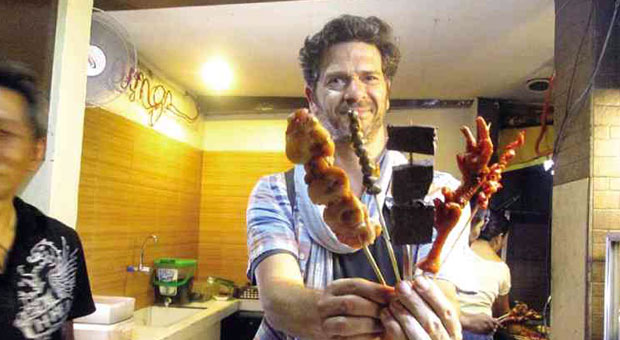The National Geographic show “Street Food Around the World” is a fun program to watch—but last Dec. 14, it turned out to be even more topically interesting and view-worthy, because it featured Filipino street food in the byways and cul-de-sacs of Manila! Its peripatetic, hyper-enthusiastic and apparently constantly hungry host is obviously ready, willing and able to eat anything and everything—including live, twitching shrimps, pig’s blood and balut!
So did he do full justice to the extremely wide range of exotic and even erotic ingestibles and digestibles that have become part of our macadam lives—and (budget) tummies?
The adventurous and peripatetic host’s introduction to the Pinoy’s favored taste-ticklers began safely enough with such inexpensive staples as “banana cue” and halo-halo—but also included unusual breakfast fare like champorado and salted fish.
Then came the live shrimps in a squirming salad not for the faint-hearted, followed by a really yummy okoy.
So by the time the usual tourist shocker, balut, was brought in for predictably controversial delectation, the host’s hungry tummy had already been primed for unconventional and “chest-hair growing” gustatory and culinary tactics, shticks—and tics!
Another highlight of the lightning culinary tour of Manila’s hungry underbelly was the bemused visitor’s “you-gotta-be-kidding!” discovery that Pinoys don’t only eat all sorts of innards and stuff, but have also even coined really witty pet names for them—like IUD, Helmet, Adidas, Betamax, etc.! To be sure, some wild and wooly mis-information was cheerfully dispensed once in a while. For instance, the program host wanted to know what Pinoys shouted when they toasted each other with lethal fire water, and somebody shouted, “Kampai!” Must have ben a straggler who just crawled out of a cave in Mindoro, a former member of the—Kempeitai?
A mine field
Another “extreme” cooking and eating show that recently spiced up our viewing week was set in Seoul, Korea, where a European master chef spent close to a week to imbibe and ingest that city’s culinary culture. The challenge for him was not just to “understand” Korean food, but also to use the insightful comprehension to create a meal—for Korean food critics!
The culinary challenge was as daunting and full of risk and danger as having to walk (on eggs!) across a mine field in Cambodia!
But the “suicidal” master chef took the bull by the horns—and came up with a truly masterful “deconstruction and reconstruction” of the exotic dishes he had previously sampled and insightfully analyzed—and elaborated upon!
Aside from being a culinary tour de force, the special challenge was a tribute, not just to the richness of Korean cuisine, but also to the wellsprings of creativity itself, regardless of national or regional contexts.
Some people pooh-pooh cooking talent as more craft than art, but the “Challenge in Korea” telecast showed nothing less than a true master and artist at work.
Yes, his “paints” may have been of the edible sort, but his creations weren’t just delicious, they were ideationally and even philosophically amazing to boot!
